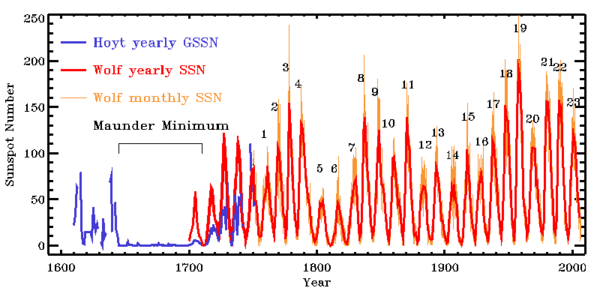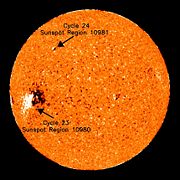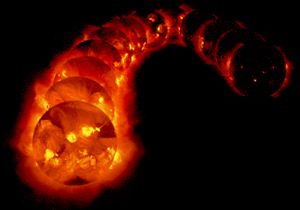Solar cycle
2008/9 Schools Wikipedia Selection. Related subjects: Climate and the Weather
The solar cycle, or the solar magnetic activity cycle, is the dynamical engine and energy source behind all solar phenomena driving space weather. Powered by a hydromagnetic dynamo process relying on the inductive action of internal solar flows, the solar cycle
- structures the sun's atmosphere, corona and wind;
- modulates the solar irradiance;
- modulates the flux of short-wavelength solar radiation, from ultraviolet to X-Ray;
- modulates the occurrence frequency of flares, coronal mass ejections, and other geoeffective solar eruptive phenomena;
- indirectly modulates the flux of high-energy galactic cosmic rays entering the solar system.
History
The solar cycle was discovered in 1843 by Samuel Heinrich Schwabe, who after 17 years of diligent observations of the sun noticed a periodic variation in the average number of sunspots seen from year to year on the solar disk. Very much impressed by Schwabe's discovery, Rudolf Wolf compiled and studied earlier observations, and managed to reconstruct the cycle back to 1745, eventually pushing these reconstructions to the earliest observations of sunspots by Galileo and contemporaries in the opening decades of the seventeenth century. Because sunspots come in many sizes and different levels of grouping, starting with Wolf solar astronomers have found it useful to define a standard sunspot number index, which continues to be used today.
The average duration of the sunspot cycle is 11.1 years, but cycles as short as 9 years and as long as 14 years have been observed. Significant variations in amplitude also occur. Solar maximum and solar minimum refer respectively to epochs of maximum and minimum sunspot counts. Individual sunspot cycles are partitioned from one minimum to the next.
Following the numbering scheme established by Wolf, the 1755-1766 cycle is traditionally numbered "1". The period between 1645 and 1715, a time during which very few sunspots were observed, is a real feature, as opposed to an artifact due to missing data. This epoch is now known as the Maunder minimum, after Edward Walter Maunder, who extensively researched this peculiar event, first noted by Gustav Spörer. In the second half of the nineteenth century it was also noted (independently) by Richard Carrington and by Spörer that as the cycle progresses, sunspots appear first at mid-latitudes, and then closer and closer to the equator until solar minimum is reached. This pattern is best visualized in the form of the so-called butterfly diagram, first constructed by the husband-wife team of E. Walter and Annie Maunder in the early twentieth century (see Figure 2). Images of the sun are divided into latitudinal strips, and the monthly-averaged fractional surface of sunspots calculated. This is plotted vertically as a colour-coded bar, and the process is repeated month after month to produce this time-latitude diagram.
The physical basis of the solar cycle was elucidated in the early twentieth century by George Ellery Hale and collaborators, who in 1908 showed that sunspots were strongly magnetized (this was the first detection of magnetic fields outside the Earth), and in 1919 went on to show that the magnetic polarity of sunspot pairs:
- is always the same in a given solar hemisphere throughout a given sunspot cycle;
- is opposite across hemispheres throughout a cycle;
- reverses itself in both hemispheres from one sunspot cycle to the next.
Hale's observations revealed that the solar cycle is a magnetic cycle with an average duration of 22 years. However, because very nearly all manifestations of the solar cycle are insensitive to magnetic polarity, it remains common usage to speak of the "11-year solar cycle".
Half a century later, the father-and-son team of Harold Babcock and Horace Babcock showed that the solar surface is magnetized even outside of sunspots; that this weaker magnetic field is to first order a dipole; and that this dipole also undergoes polarity reversals with the same period as the sunspot cycle (see Fig. 3 below). These various observations established that the solar cycle is a spatiotemporal magnetic process unfolding over the sun as a whole.

Impacts of the solar cycle
The sun's magnetic field structures its atmosphere and outer layers all the way through the corona and into the solar wind. Its spatiotemporal variations leads to a host of phenomena collectively known as solar activity. All of solar activity is strongly modulated by the solar magnetic cycle, since the latter serves as the energy source and dynamical engine for the former.
Surface magnetism
Sunspots may exist anywhere from a few days to a few months, but they eventually decay, and this releases magnetic flux in the solar photosphere. This magnetic field is dispersed and churned by turbulent convection, and solar large-scale flows. These transport mechanisms lead to the accumulation of the magnetized decay products at high solar latitudes, eventually reversing the polarity of the polar fields (see Fig. 3).

The dipolar component of the solar magnetic field is observed to reverse polarity around the time of solar maximum, and reaches peak strength at the time of solar minimum. Sunspots, on the other hand, are produced from a strong toroidal (longitudinally-directed) magnetic field within the solar interior. Physically, the solar cycle can be thought of as a regenerative loop where the toroidal component produces a poloidal field, which later produces a new toroidal component of sign such as to reverse the polarity of the original toroidal field, which then produces a new poloidal component of reversed polarity, and so on.
Solar irradiance
The total solar irradiance (TSI) is the amount of solar radiative energy impinging on the Earth's upper atmosphere. It is observed to vary in phase with the solar cycle, with yearly averages going from 1365.5 Watt per square meter at solar minimum, up to 1366.6 at solar maximum, with fluctuations about the means of about +/- 1 Watt per square meter on timescales of a few days (see Figure 4, yellow and red curves). The min-to-max variation, at the 0.1% level, is far too small to affect Earth's climate, but it is worth keeping in mind that continuous reliable measurements of the TSI are only available since 1978; the minimum and maximum levels of solar activity have remained roughly the same from then to now, spanning cycle 21 through 23.

Interestingly, the Sun is slightly brighter at solar maximum, even though sunspots are darker than the rest of the solar photosphere. This is because at solar maximum, a great many magnetized structures other than sunspots appear on the solar surface and many of them, such as faculae and active elements of the network, are brighter than the photosphere. They collectively end up slightly overcompensating for the overall irradiance deficit associated with the larger but less numerous sunspots. Recent observations indicate that the primary driver of TSI changes is the varying photospheric coverage of these different types of solar magnetic structures , although contributions from long-timescale variations associated with a deep-seated physical process, such as cycle-mediated small changes in the efficiency of convective energy transport, cannot be ruled out entirely as yet.
Short-wavelength radiation
With a temperature 5870 kelvins, the unmagnetized regions of the Sun's atmosphere emit very little short-wavelength radiation, such as extreme ultraviolet (EUV) and X-Rays. This is no longer the case where magnetic fields are present, magnetized regions being observed to emit short-wavelength radiation. Since surface coverage of magnetic structures varies markedly in the course of the cycle, the level of diffuse, non-flaring solar UV, EUV and X-Ray flux is modulated accordingly Figure 5 illustrates this variations for soft X-Ray, as observed by the Japanese satellite YOHKOH. Similar cycle-related variations are observed in the flux of solar UV or EUV radiation, as observed for example by the SOHO or TRACE satellites.
Even though it only accounts for a minuscule fraction of the total solar irradiance, the impact of solar UV, EUV and X-Ray radiation on the Earth's upper atmosphere are profound. The solar UV flux is a major driver of stratospheric chemistry, and the ionosphere responds strongly to increases in ionizing radiation, through heating and changes in electrical conductivity.
Solar radio flux
Emission from the Sun at centimetric (radio) wavelength is due primarily to coronal plasma trapped in the magnetic fields overlying active regions . The F10.7 index is a measure of the solar radio flux per unit frequency at a wavelength of 10.7cm, near the peak of the observed solar radio emission. It represents a measure of diffuse, nonradiative heating of the coronal plasma trapped by magnetic fields over active regions, and is an excellent indicator of overall solar activity levels. The solar F10.7 cm record extends back to 1947, and is the longest direct record of solar activity available, other than sunspot-related quantities.
It has been proposed that 10.7 cm solar flux can interfere with point-to-point terrestrial communications. "The Effect of 10.7 cm Solar Radiation on 2.4GHz Digital Spread Spectrum Communications", NARTE News, Volume 17 Number 3 July - October 1999.
Geoeffective eruptive phenomena
The solar magnetic field structures the corona, giving it its characteristic shape visible at times of solar eclipses. Complex coronal magnetic field structures evolve in response to fluid motions at the solar surface, and emergence of magnetic flux produced by dynamo action in the solar interior. For reasons not yet understood in detail, sometimes these structures lose stability, leading to coronal mass ejections into interplanetary space, or flares, caused by sudden localized release of magnetic energy driving copious emission of ultraviolet and X-ray radiation as well as energetic particles. These eruptive phenomena can have a significant impact on Earth's upper atmosphere and space environment, and are the primary drivers of what is now called space weather.
The occurrence frequency of coronal mass ejections and flares is strongly modulated by the solar activity cycle. Flares of any given size are some 50 times more frequent at solar maximum than at minimum. Large coronal mass ejections occur on average a few times a day at solar maximum, down to one every few days at solar minimum The size of these events themselves does not depend sensitively on the phase of the solar cycle. A good recent case in point are the three large X-class flares having occurred in December 2006, very near solar minimum; one of these (an X9.0 flare on Dec 5) stands as one of the brightest on record.
Cosmic ray flux
The outward expansion of solar ejecta into interplanetary space provides overdensities of plasma that are efficient at scattering high-energy cosmic rays entering the solar system from elsewhere in the galaxy. Since the frequency of solar eruptive events is strongly modulated by the solar cycle, the degree of cosmic ray scattering in the outer solar system varies in step. As a consequence, the cosmic ray flux in the inner solar system is anticorrelated with the overall level of solar activity. This anticorrelation is clearly detected in cosmic ray flux measurements at the Earth's surface.
Some high-energy cosmic rays entering Earth's atmosphere collide hard enough with molecular atmospheric constituents to cause occasionally nuclear spallation reactions. Some of the fission products include radionuclides such as 14C and 10Be, which settle down on Earth's surface. Their concentration can be measured in ice cores, allowing a reconstruction of solar activity levels into the distant past . Such reconstructions indicate that the overall level of solar activity since the middle of the twentieth century stands amongst the highest of the past 10,000 years, and that Maunder minimum-like epochs of suppressed activity, of varying durations have occurred repeatedly over that time span.
Impact on Biosphere and human circadian cycle
The impact of Solar cycle on living organisms is covered in part by interdisciplinary studies in the fields of science known as Chronobiology, Heliobiology, and Astrobiology. In 1924 Alexander Chizhevsky, graduate of Medical School at Moscow University, published interdisciplinary works: "Physical factors behind the process of history" and "Epidemiological catastrophes and periodic activity of the Sun" studying cycles in living organisms in connections with solar cycle and cycle of lunar phases. Chizhevsky developed a new discipline, Heliobiology, a branch of Astrobiology. In 1939 Chizhevsky was elected Honorary President of International Congress in Biological Physics, for his 1936 publication The Terrestrial Echo of Solar Storms, 366 pp. 1976, Moscow, (First published in 1936 in Russian: А.Л.Чижевский. Земное эхо солнечных бурь. full text in Russian ). However, soon Chizhevsky was arrested by the Soviet government and exiled to Siberia under the dictatorship of Joseph Stalin. Chizhevsky's publications were censored and his 1930s research of blood and electromagnetic parameters of erythrocytes in connection with cycles in human circadian system was banned, it was published 40 years later, in 1973. Chizhevsky's 1928 publication "Influence of Cosmos on human psychoses" was censored in the Soviet Union, albeit in 2003 this work was referenced in Journal of Circadian Rhythms article.





